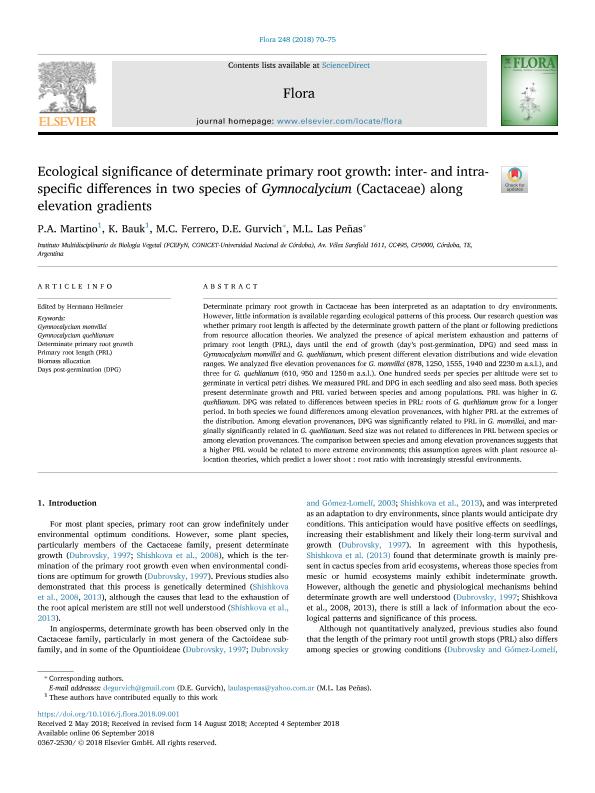Mostrar el registro sencillo del ítem
dc.contributor.author
Martino, P. A.
dc.contributor.author
Bauk, Karen

dc.contributor.author
Ferrero, María Cecilia

dc.contributor.author
Gurvich, Diego Ezequiel

dc.contributor.author
Las Peñas, Maria Laura

dc.date.available
2019-11-04T15:12:57Z
dc.date.issued
2018-11
dc.identifier.citation
Martino, P. A.; Bauk, Karen; Ferrero, María Cecilia; Gurvich, Diego Ezequiel; Las Peñas, Maria Laura; Ecological significance of determinate primary root growth: inter- and intra-specific differences in two species of Gymnocalycium (Cactaceae) along elevation gradients; Elsevier Gmbh; Flora; 248; 11-2018; 70-75
dc.identifier.issn
0367-2530
dc.identifier.uri
http://hdl.handle.net/11336/87877
dc.description.abstract
Determinate primary root growth in Cactaceae has been interpreted as an adaptation to dry environments. However, little information is available regarding ecological patterns of this process. Our research question was whether primary root length is affected by the determinate growth pattern of the plant or following predictions from resource allocation theories. We analyzed the presence of apical meristem exhaustion and patterns of primary root length (PRL), days until the end of growth (day's post-germination, DPG) and seed mass in Gymnocalycium monvillei and G. quehlianum, which present different elevation distributions and wide elevation ranges. We analyzed five elevation provenances for G. monvillei (878, 1250, 1555, 1940 and 2230 m a.s.l.), and three for G. quehlianum (610, 950 and 1250 m a.s.l.). One hundred seeds per species per altitude were set to germinate in vertical petri dishes. We measured PRL and DPG in each seedling and also seed mass. Both species present determinate growth and PRL varied between species and among populations. PRL was higher in G. quehlianum. DPG was related to differences between species in PRL: roots of G. quehlianum grow for a longer period. In both species we found differences among elevation provenances, with higher PRL at the extremes of the distribution. Among elevation provenances, DPG was significantly related to PRL in G. monvillei, and marginally significantly related in G. quehlianum. Seed size was not related to differences in PRL between species or among elevation provenances. The comparison between species and among elevation provenances suggests that a higher PRL would be related to more extreme environments; this assumption agrees with plant resource allocation theories, which predict a lower shoot : root ratio with increasingly stressful environments.
dc.format
application/pdf
dc.language.iso
eng
dc.publisher
Elsevier Gmbh

dc.rights
info:eu-repo/semantics/openAccess
dc.rights.uri
https://creativecommons.org/licenses/by-nc-sa/2.5/ar/
dc.subject
BIOMASS ALLOCATION
dc.subject
DAYS POST-GERMINATION (DPG)
dc.subject
DETERMINATE PRIMARY ROOT GROWTH
dc.subject
GYMNOCALYCIUM MONVILLEI
dc.subject
GYMNOCALYCIUM QUEHLIANUM
dc.subject
PRIMARY ROOT LENGTH (PRL)
dc.subject.classification
Genética y Herencia

dc.subject.classification
Ciencias Biológicas

dc.subject.classification
CIENCIAS NATURALES Y EXACTAS

dc.title
Ecological significance of determinate primary root growth: inter- and intra-specific differences in two species of Gymnocalycium (Cactaceae) along elevation gradients
dc.type
info:eu-repo/semantics/article
dc.type
info:ar-repo/semantics/artículo
dc.type
info:eu-repo/semantics/publishedVersion
dc.date.updated
2019-10-24T18:35:32Z
dc.journal.volume
248
dc.journal.pagination
70-75
dc.journal.pais
Alemania

dc.description.fil
Fil: Martino, P. A.. Consejo Nacional de Investigaciones Científicas y Técnicas. Centro Científico Tecnológico Conicet - Córdoba. Instituto Multidisciplinario de Biología Vegetal. Universidad Nacional de Córdoba. Facultad de Ciencias Exactas Físicas y Naturales. Instituto Multidisciplinario de Biología Vegetal; Argentina
dc.description.fil
Fil: Bauk, Karen. Consejo Nacional de Investigaciones Científicas y Técnicas. Centro Científico Tecnológico Conicet - Córdoba. Instituto Multidisciplinario de Biología Vegetal. Universidad Nacional de Córdoba. Facultad de Ciencias Exactas Físicas y Naturales. Instituto Multidisciplinario de Biología Vegetal; Argentina
dc.description.fil
Fil: Ferrero, María Cecilia. Consejo Nacional de Investigaciones Científicas y Técnicas. Centro Científico Tecnológico Conicet - Córdoba. Instituto Multidisciplinario de Biología Vegetal. Universidad Nacional de Córdoba. Facultad de Ciencias Exactas Físicas y Naturales. Instituto Multidisciplinario de Biología Vegetal; Argentina
dc.description.fil
Fil: Gurvich, Diego Ezequiel. Consejo Nacional de Investigaciones Científicas y Técnicas. Centro Científico Tecnológico Conicet - Córdoba. Instituto Multidisciplinario de Biología Vegetal. Universidad Nacional de Córdoba. Facultad de Ciencias Exactas Físicas y Naturales. Instituto Multidisciplinario de Biología Vegetal; Argentina
dc.description.fil
Fil: Las Peñas, Maria Laura. Consejo Nacional de Investigaciones Científicas y Técnicas. Centro Científico Tecnológico Conicet - Córdoba. Instituto Multidisciplinario de Biología Vegetal. Universidad Nacional de Córdoba. Facultad de Ciencias Exactas Físicas y Naturales. Instituto Multidisciplinario de Biología Vegetal; Argentina
dc.journal.title
Flora

dc.relation.alternativeid
info:eu-repo/semantics/altIdentifier/url/https://linkinghub.elsevier.com/retrieve/pii/S0367253018302810
dc.relation.alternativeid
info:eu-repo/semantics/altIdentifier/doi/http://dx.doi.org/10.1016/j.flora.2018.09.001
Archivos asociados
